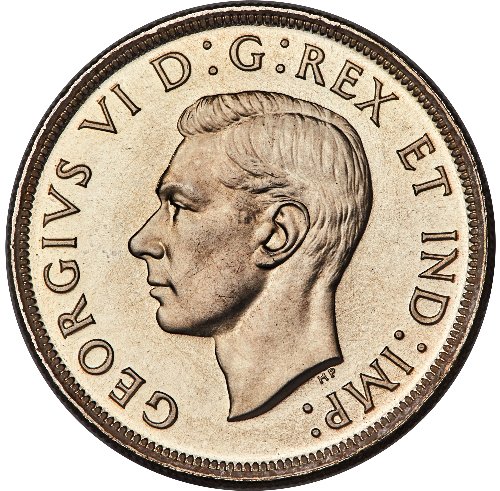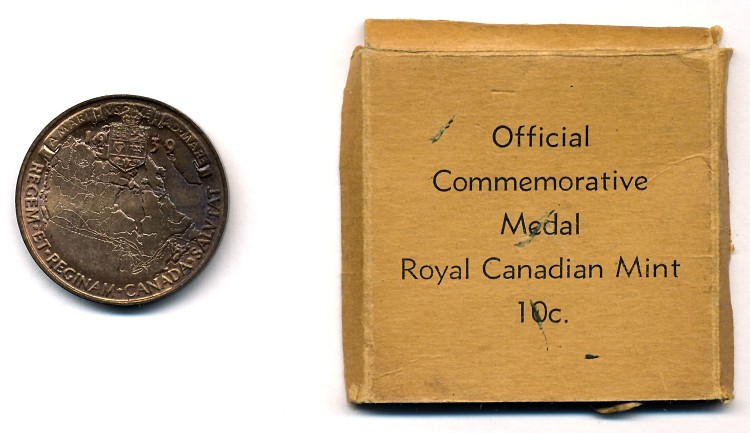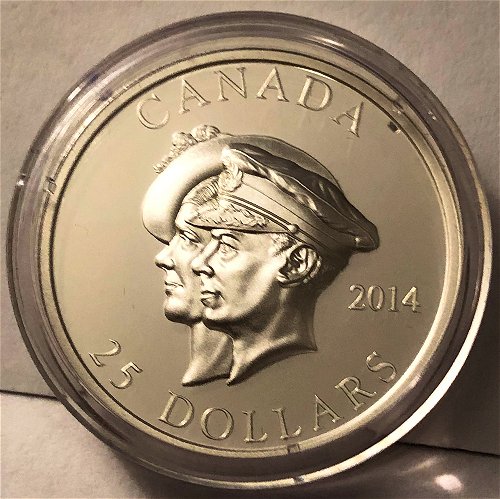I mentioned in another post that I purchased two Christmas presents for myself. One was a
2009 Japan-Canada Proof Set (the subject of the other post) and one was a 2014 75th Anniversary of the Royal Visit of 1939 $25 silver coin.
The King George VI and Queen Elizabeth visited Canada from May 17, 1939, when they arrived in Quebec via the royal yacht
Empress of Australia, through June 15, 1939 when they departed Newfoundland for home aboard the ocean liner RMS
Empress of Britain.
My primary Canadian coin collection consists of the various 36 millimeter (mm) commemorative silver dollars (SDs) that the
RCM has issued since 1935 - circulation coins and non-circulating legal tender (NCLT) coins alike. As my set is essentially complete at this point, I find myself looking for other coins to supplement my collection without straying too far afield. One such supplement is a $25 silver coin from 2014 - it's an ultra-high relief (UHR) silver coin that commemorates the 75th anniversary of the 1939 royal visit to Canada by the Royal Couple.
The link to my existing collection comes via the circulating commemorative SD Canada issued in 1939 to celebrate the royal visit. It was the first visit to Canada by the reigning monarch, and was a big deal across Canada with large, enthusiastic crowds greeting King George VI and Queen Elizabeth wherever they made tour stops.

 Images courtesy of Heritage Auctions, http://www.ha.com.
Images courtesy of Heritage Auctions, http://www.ha.com.The commemorative reverse of the 1939 SD features the center block and Peace Tower of Canada's Parliament Buildings in Ottawa. Seen at the top rim is the inscription (in Latin) "FIDE SVORVM REGNAT" which translates to "He reigns by the faith of his people." The inscriptions "CANADA," "1939" and "1 DOLLAR" are presented below the building. The design was created by Emmanuel Hahn, the same artist responsible for the famous Voyageur design used on Canada's silver and nickel dollars for more than 50 years.
Compared to the SD, the more obvious nod to the Royal Visit came from the medals struck by the
RCM. The reverse of the medals feature a map of Canada and the route the Royal Couple took as they crisscrossed the country. Shown here are my examples of the silver (obverse) and bronze (reverse) medals (with their somewhat tattered original boxes).


Fortunately, the 2014 coin does not simply mimic the 1939 SD. Instead of symbolically depicting the Government of Canada via its Parliament Buildings as was done in 1939, the 2014 coin focuses on the Royal Couple; it features conjoined portraits similar in style to the 1939 medal.
I decided to add the coin to my set recently for several reasons:
1) I like the direct tie-in to the 1939 commemorative dollar.
2) The coin is 36 mm in diameter and a nice match to all of the 36 mm SDs in my collection (in fact, the coin uses the same 36 mm planchet the
RCM uses for its UHR SDs [including the recent 2020-dated
Peace dollar]).
3) I like the
RCM's UHR coins, especially when the design is simple and the UHR engraving is used to bring focus to selected design elements vs. the entire coin's surface.
4) I found one at what I considered to be a great price - just 31% of its issue price - about $46 CAD vs. an issue price of $149.95. As the coin is a supplement to my core collection, I was pleased to find the coin at such a good price. (I did not and would not buy the coin at its
RCM issue price - it was too high for a coin of limited appeal.)
The maximum mintage was listed as 6,000, but per the
RCM's Annual Report for 2014 and 2015, it appears that sales of the coin over the time it was available totaled just 3,117 or roughly 52% of the maximum. As I mentioned above, it is a coin with limited appeal.
The proof coin was struck on a 36 mm planchet with a weight of 30.76 grams; it is 0.9999 fine silver. As with the
RCM's other UHR coins struck on this planchet, the coin's edge is plain.

The obverse of the coin features the Susanna Blunt portrait of QEII. The coin's commemorative reverse features the conjoined portraits of King George VI and Queen Elizabeth. The King is shown wearing his military hat to reflect the military attire he wore during much of the 1939 visit. The two portraits are the coin's UHR design elements - the effigies most definitely "pop" from the flat reverse fields.
The
RCM's description of the coin states that the UHR was achieved by striking the coin four times. Many proof coins are double-struck on specially-prepared planchets to produce their crisp details; the results produced by the quadruple strike used on this coin are certainly impressive - the portraits look great!
I'm happy to have added the coin to my collection. Its traditional design and execution fit well with my sensibilities as a collector and its direct link to one of Canada's classic commemorative SDs already in my collection simply "works" for me.
Hope you enjoyed the read and images!
PS I can hardly wait to see what I get myself next year!























